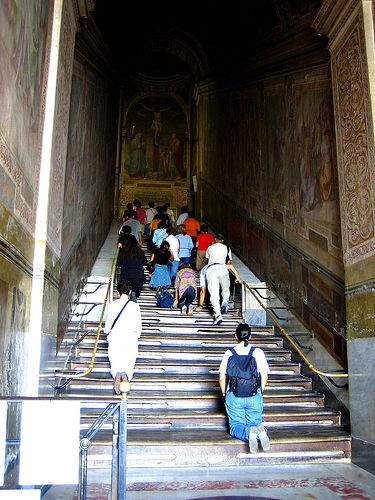
The Italians have a great deal of belief in relics of their religion and Rome is a hot bed of these items. Some of the relics are incredibly well known while others are much more obscure, but regardless it is clear that the Romans have given great honor to saintly relics over the centuries.
Scala Santa
This famous staircase was brought to Rome by St. Helena, the mother of the first Christian emperor, Constantine. The marble staircase originated in Jerusalem but was brought to and placed in Rome across from the basilica of S. Giovanni in Laterano. The 28 stairs are said to be the same stairs that Jesus Christ walked up on the day of his trial. Originally owned by Pontius Pilate, the Scala Santa draws eager worshipers all months of the year, but especially during Lent. It is believed by Catholics that climbing the stairs on your knees keeps you from serving any forms of punishment in purgatory. The steps are popular for worshipers of all ages.
S. Croce in Gerusalemme
A church built in the 4th century, S. Croce in Gerusalemme was built to house the trophies of St. Helena from the Holy Land. Inside the stark chapel, you’ll find fragments of the cross upon which Christ died and a nail from the actual crucifixion. In addition, a wooden plaque reads “Jesus of Nazareth king of the Jews” in Greek, Latin and Hebrew. The church also has relics of the good thief who hung beside Jesus Christ in crucifixion. The horizontal plank of his cross is present in the church. The severed finger of Apostle Thomas is stored here as well. It is said that the finger present at S. Croce is the same one that Thomas used to touch Jesus’ wound in his side.
Ss. Vincenzo e Anastasio on Piazza Trevi
Certainly more modern, but just as intriquing, Ss. Vincenzo e Anastasio has a collection of organs from every Pope who lived in the nearby Palazzo Quirinale. The collection includes the liver, spleen and pancreas of Pope Sixtus V (1585-1590) through Leo XIII (1878-1903). These organs were removed from the bodies of the Popes after death as the bodies were preparing to be embalmed. These relics were set aside for use in the local churches, as they are being used today.


